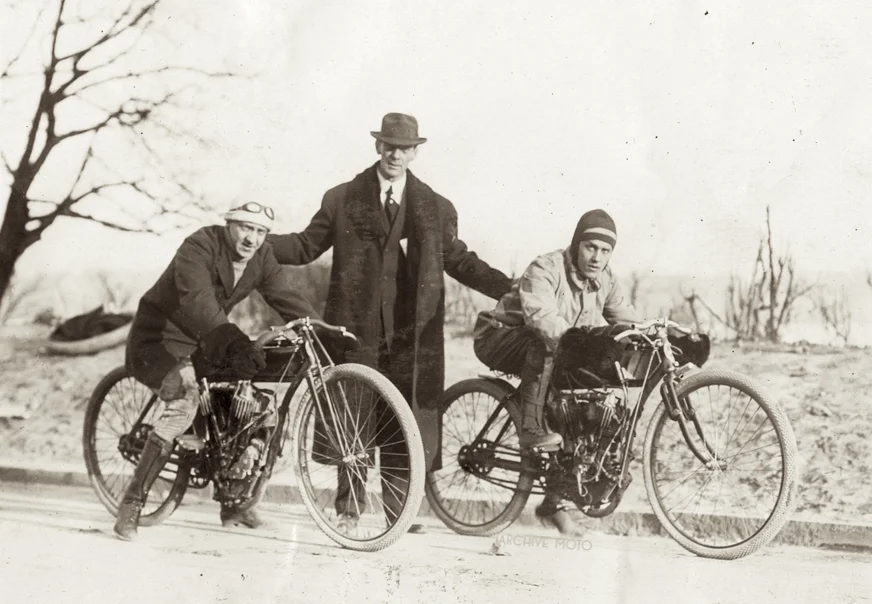Arthur G. Chapple and Walter Goerke, two of America’s finest motorcycle racers are seen here posing just before a hill climb competition in December 1909. True pioneers of both the sport and the culture, Chapple and Goerke can be counted amongst the most influential of American motorcycling’s founding fathers. The two friends from Brooklyn began their love affair with motorcycles as soon as the new machines first appeared in stateside. They participated in the creation of America’s first organization to oversee club life and race sanctioning, the Federation of American Motorcyclists, as well as became founding members of one of the earliest motorcycle clubs in the United States, the NYMC. They went on to form another prestigious club in the area, Brooklyn’s Invincible M.C., and as time progressed could be found assisting other groups in city’s across the country form their own motorcycle clubs. They too wasted no time in getting to the track, both men were very active entrants in early horse track and endurance competitions.
Given their talent and experience, both Chapple and Goerke were among the first to be recruited by Indian’s Oscar Hedstrom when he created the Springfield manufacturer’s first factory racing team. It was at that point that the two men became national celebrities, pioneering the sport of motordrome racing, and both setting and shattering speed records on dirt, sand, and timber. Brooklyn’s fastest duo, the teammates were constant features in the day’s press and were already veterans during the Goden Age of motorcycle racing. Chapple, typically the subject of popular articles began to author them himself, becoming a trusted voice within the growing industry of the sport. He then became the foremost proponent of the preparedness movement in America, penning articles, giving speeches, and rallying support throughout the country’s motorcycle enthusiast community to enlist for service, and train to serve the country onboard two-wheels. Goerke continued racing well into his 30’s, moving into the business side of motorcycling in the late-teens, eventually opening his own Indian dealership in New Jersey and even having a coveted trophy named in his honor in the state’s annual endurance race.
The men are photographed onboard their factory Indian twin racers with a yet to be identified gentleman just before the Fort Lee Hill Climb on December 4, 1909. Staged in the palisades of New Jersey, just across New York’s George Washington Bridge had it been there at the time, the race took off a short distance away from the Fort Lee Ferry in Edgewater. The route was a 3,000 foot, twisty ascent up to the village of Fort Lee boasting an average grade of 12 percent, though at its steepest was nearly 20 percent. Unable to cure its own enthusiasm, the crowd that gathered to watch the event grew too large and eager for the local police to manage. As they spilled off of porches and into the street, gradually narrowing the route, the event’s officials were forced to terminate the event halfway through. The cancelation came just before Chapple and Goerke’s run in the twin cylinder class, though both men were able to complete their runs in the singles class. Chapple piloted his Indian 30.50ci Indian single up the grade to Fort Lee in 50.15 seconds, an average speed of 41 mph, the fastest machine of the day on either two or four wheels. Goerke too was in the running for the hottest lap in the single event, but took a hard spill on the final turn at the top of the Fort Lee ascent. The pair were certain to set even faster times for the day in the twin class, their bread and butter, but the cancelation prevented them from what would have surely been a memorable affair.

